Did you know over 90% of road mishaps come from human mistakes? This shows how vital it is to drive carefully. Keeping safe on the road isn’t just following traffic rules. It’s about the small choices you make while driving.
There are many ways to stay safe, like making sure you can see well and signaling to other drivers. By driving safely, you’re not just protecting yourself. You also keep others on the road safe. It’s important to know how to drive safely, be skilled, and have a good attitude. Being polite, watching out, and being ready for different driving situations can greatly improve safety.
Following these tips can help stop car accidents and make driving better for everyone. Keep watching for more tips and info to help you drive more safely.
Understanding Traffic Laws and Regulations in Canada
Traffic laws in Canada cover federal, provincial, and municipal levels.
They ensure road safety for everyone. We will look at how these laws work together.
Federal, Provincial, and Municipal Laws
Canada’s traffic laws are complex because they are divided across different levels. The federal government sets vehicle standards. Provinces adapt these rules to fit their needs. Cities handle local road rules and parking.
Enforcement and Consequences
Enforcement is key to following these rules. Police play a big role. Breaking the law can lead to fines, points on your license, and even jail. Following these laws keeps roads safe.
Canada’s Role in Traffic Safety
Canada aims to make traffic laws consistent across the country. The government works with provinces and territories for safer roads. Efforts like Vision Zero show this commitment. Improving road safety is an ongoing effort.
Importance of Defensive Driving Techniques
Learning defensive driving techniques is vital for your safety and the safety of others. These include keeping proper visibility, maintaining safe distances, and clear communication with other drivers. By using these methods, you can better predict and avoid dangers, making the roads safer for everyone.
Visibility: Seeing and Being Seen
Being visible is a big part of defensive driving. It’s important to make sure you can see others and they can see you. Check your mirrors regularly, keep headlights clean, and use them right. Turning on signals early lets others know your plans, helping avoid crashes.
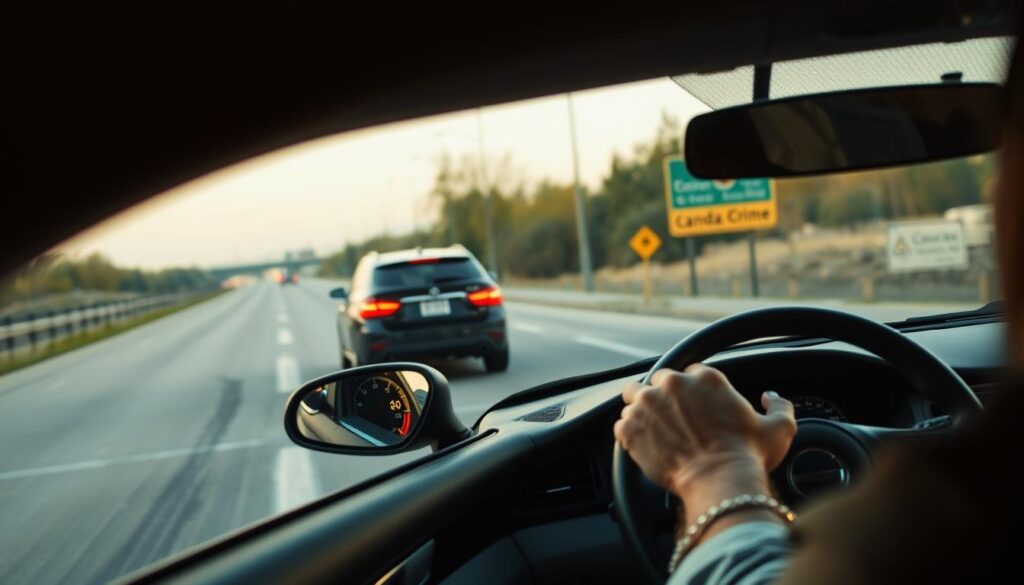
Maintaining Safe Distances
Staying a safe distance from other cars is a key safety tactic. It gives you time to stop if something unexpected happens. You should keep a three-second gap from the car in front of you. Doing this, especially in bad weather, can stop accidents and keep the roads safe.
Effective Communication with Other Drivers
Good communication with other drivers is crucial in defensive driving. Use signals, brake lights, and hazard lights to tell others what you’re doing. Making eye contact at key points also helps clear up what everyone is doing. This can reduce the chances of accidents due to confusion.
Sharing the Road with Other Users
Sharing the road is key to driving safely. We share roads with pedestrians, cyclists, motorcyclists, and large trucks. Each group has its own way of using the road. By understanding and respecting these differences, we make the road safer for everyone.

Pedestrians, Cyclists, and Motorcyclists
Drivers should give way to pedestrians, especially in crosswalks. Making eye contact helps keep them safe. Be extra careful around schools, neighborhoods, and during dusk.
Sharing the road with cyclists means giving them space. Watch out for them moving unexpectedly. Motorcyclists are smaller and harder to spot. Always check your blind spots and signal your moves clearly.
Commercial Motor Vehicles
Large trucks and buses have big blind spots and need more time to stop. Don’t follow them too closely. If you can’t see their mirrors, they can’t see you. Slow-moving vehicles like farm equipment and horse-drawn carriages show an orange and red sign. Keep a safe distance and pass with care.
Stop for school buses showing red lights or stop signs. This keeps kids safe as they get on or off the bus.
| Road User | Driving Tips |
|---|---|
| Pedestrians | Yield at crosswalks, make eye contact, watch for children |
| Cyclists | Give one-meter space, watch for sudden movements |
| Motorcyclists | Check blind spots, signal intentions clearly |
| Commercial Vehicles | Beware of blind spots, maintain distance, do not tailgate |
| Farm Machinery | Pass carefully, respect slow-moving signs |
| School Buses | Stop for flashing red lights, watch for children |
Driving carefully and adjusting to others’ needs makes roads safer for all. Stay alert and ready to adapt your driving. This way, we all contribute to a safer environment.
Tips to Prevent Dangerous Operation of a Motor Vehicle
Following tips to prevent dangerous operation of a motor vehicle means sticking to important safety rules. Always obey road safety laws designed to keep drivers and walkers safe. Abiding by traffic signals, speed limits, and rules cuts down accident risks.
Using defensive driving is key to avoiding risky behavior on the road. It means being ready and spotting dangers early to stay safe. Always keep a safe distance from the car in front to react well to sudden stops or traffic changes.
Keeping your vehicle in good shape lowers the chance of breaking down or mechanical issues. Check your car’s brakes, tires, lights, and fluid levels regularly. Sticking to a maintenance schedule keeps your car running smoothly and safely.
Avoiding distractions while driving is crucial. Texting, eating, or messing with your car’s tech can take your attention off the road. Staying focused on driving helps you deal with surprises better.
Knowing the road conditions and traffic signs also helps in preventing risky driving behaviors. Drive slower in bad weather and watch out for construction and people crossing.
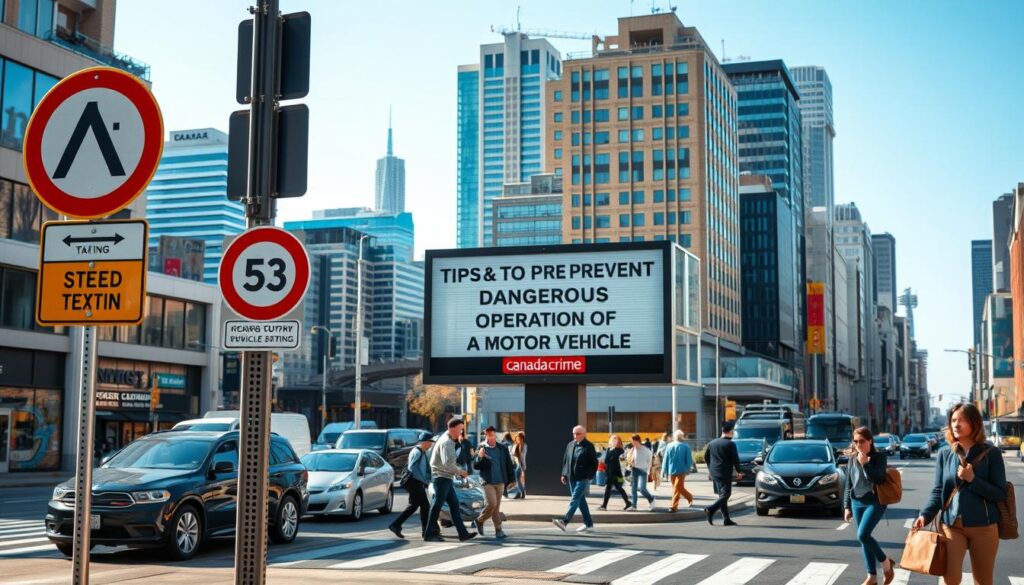
By using these tips every day, you help make roads safer and reduce accidents. Safe driving begins with you. Making smart choices when driving saves lives.
Dealing with Emergency Situations
When you’re on the road, thinking fast and staying calm is key during emergencies. This includes recognizing dangers, dealing with your car breaking down, or knowing what to do if there’s an accident. These tips can really help you manage tough situations well.
Recognizing and Responding to Hazards
It’s vital to spot hazards quickly to respond the right way. This means you should always watch your surroundings and know the risks. If you see something dangerous, make sure to maneuver safely around it or stop quickly if you need to. Keeping a good distance from other cars gives you time to react safely.
Handling Vehicle Breakdowns
If your car breaks down, it’s important to stay safe and keep others safe too:
- Try to move your car off the road if you can.
- Turn on your hazard lights to let other drivers know.
- Use reflective triangles or flares so you’re more visible.
- Stay in your car until help comes, especially on busy roads.
Knowing how to do simple fixes, like changing a tire, and having emergency numbers can really save the day.

Accident Procedures
If you’re in an accident, it’s overwhelming, but knowing what to do next can reduce further issues. First, check for any injuries and call for help if needed. Swap details with the other driver, and take photos of the scene if you can. Following these steps can make things easier after:
- Make sure everyone is safe.
- Write down what happened and talk to witnesses.
- Tell your insurance about the accident quickly.
Knowing how to handle these situations makes you more prepared for emergencies on the road.
Best Practices for Safe Driving in Bad Weather
Bad weather like rain, snow, and fog makes driving hard. It’s key to use careful driving skills and get your car ready for safety.
Driving in Rain, Snow, and Fog
When the weather is bad, you must change how you drive. Rain, snow, and fog make it hard to see. Use low-beam headlights to help you see better and let others see you.
Rain can cause your car to slide at about 55 km/h. By 85 km/h, you could lose control. So, slowing down keeps you safe.
Adjusting Driving Techniques for Weather Conditions
Changing how you drive in bad weather is crucial. Keep more space between you and the car ahead, at least four seconds, when it’s raining. This helps with the longer stopping time.
On snow, it takes much longer to stop, sometimes even ten times more than on dry roads. Going slower helps you stay in control and react on time.
Stopping distances for a vehicle traveling at 30 km/h are roughly 6 meters on dry roads, 22 meters on snow, and 52 meters on ice. For more tips, visit this resource.
Vehicle Preparation for Adverse Weather
Getting your car ready is as vital as driving safely. Make sure you have the right tires for snow and ice. Check your lights often so others can see you. These steps make driving in bad weather much safer.
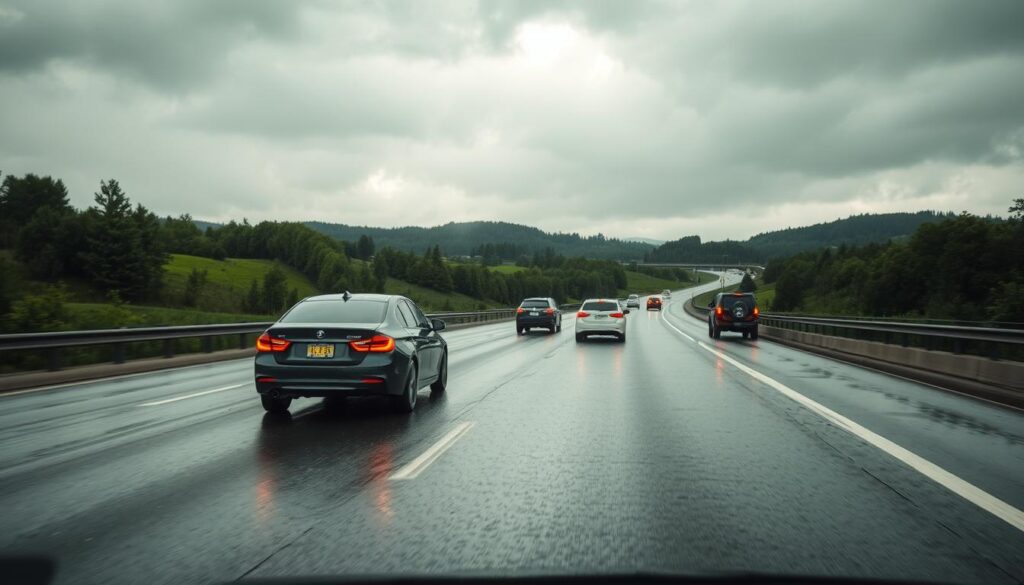
How to Drive Responsibly on Freeways
Driving safely on the freeway is crucial for everyone on the road. Knowing how to drive on these fast roads can make them safer and more efficient. Here, we’ll share important tips for making your drive safe and enjoyable.
Entering and Exiting Highways Safely
When joining or leaving a freeway, timing and attention are key. Match your speed with the current traffic when entering. On exiting, signal early, then slow down slowly to leave safely. Being ready for these moves helps avoid sudden problems and crashes.
Maintaining Speed Limits and Lane Discipline
Following speed limits is key to safe freeway driving. These limits are set for a reason, based on the road and traffic. Going too fast risks your life and others’. Staying in your lane is just as important. Stick to your lane and only switch lanes when you need to. Always use your mirrors and signal to keep safe.

Dealing with Traffic Congestion
Freeway traffic jams are common. Being patient and smart in these jams can keep you safe. Keep a safe distance from the car ahead and change lanes only if necessary. Use apps or services to find better routes and skip the worst jams. Staying calm goes a long way in avoiding accidents in busy traffic.
Following these tips helps make the roads safer for everyone. It allows all of us to travel safely and confidently.
Educational Campaigns and Outreach Programs
Educational campaigns and traffic safety outreach programs focus on teaching everyone about road safety. They aim to inform drivers, young and old, about how to drive safely. They highlight the importance of driving carefully and the dangers of not following the rules.
These programs are customized for different drivers, like newbies or truck drivers. They offer information suited to each group’s needs. This way, everyone learns how to stay safe on the roads.
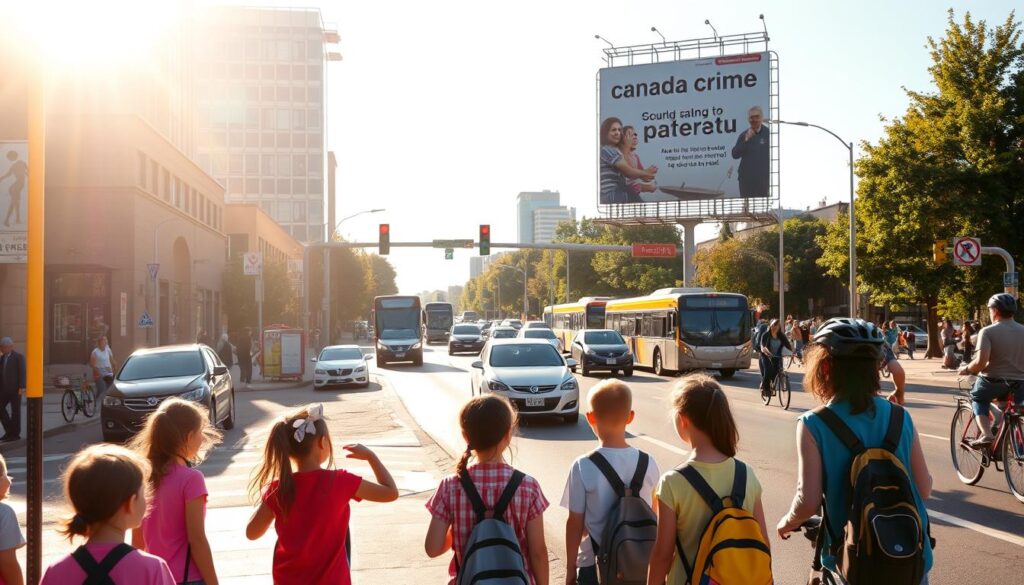
In Canada, local authorities work with schools and communities to teach road safety. These sessions happen at many places, like workplaces or community centers. They use workshops and seminars for a hands-on learning experience.
They also spread safety tips through brochures and online. This ensures more people can learn about staying safe on the roads.
Outreach programs keep the community engaged in staying safe. They use social media, news, and public announcements to spread their message. This ongoing effort helps change how people act on the road, making it safer for everyone.
After a sad accident in Hamilton, there’s a bigger push for safety at work sites. By talking about the risks workers face, outreach programs can prevent future accidents. This shows how important it is to keep everyone aware and careful.
The Role of Technology in Preventing Dangerous Driving
Modern vehicles are getting smarter, thanks to tech upgrades. These upgrades include systems to keep us safer on the road. They are part of what’s known as Advanced Driver Assistance Systems (ADAS) and other in-car tech aimed at preventing accidents.

Advanced Driver Assistance Systems (ADAS)
ADAS leads the way in making cars safer. Features like adaptive cruise control, lane-keeping help, and auto braking assist drivers. They help avoid dangers on the road.
- Adaptive Cruise Control: It adjusts speed to keep a safe distance from the car ahead, based on traffic.
- Lane-Keeping Assistance: It keeps the car in its lane, either by steering for you or alerting you.
- Automatic Emergency Braking: This feature can sense a possible crash and brake automatically to lessen or avoid the crash.
In-Vehicle Safety Features
Cars now come with many built-in safety features. These are meant to protect people inside and lower accident risks.
- Airbags: They inflate to prevent injuries during a crash.
- Seatbelt Pretensioners: These tighten seatbelts in crashes or sudden stops, holding you securely.
- Electronic Stability Control (ESC): ESC prevents skidding in tight turns, keeping the car under control.
Telematics and Driver Monitoring
Telematics and driver monitoring systems are key to stopping risky driving. They give live updates on how the car and driver are doing. This info is vital for safer roads.
- Telematics: It uses GPS and communication tech to track cars, useful for managing fleets and personal safety.
- Driver Monitoring Systems: These systems use cameras and sensors to spot if a driver is tired or distracted. They alert the driver to focus more.
Consequences of Risky Driving Behaviors
Risky driving behaviors lead to many negative results. They can bring about legal issues and impact society as a whole. The consequences span from the courtroom to affecting every one of us.
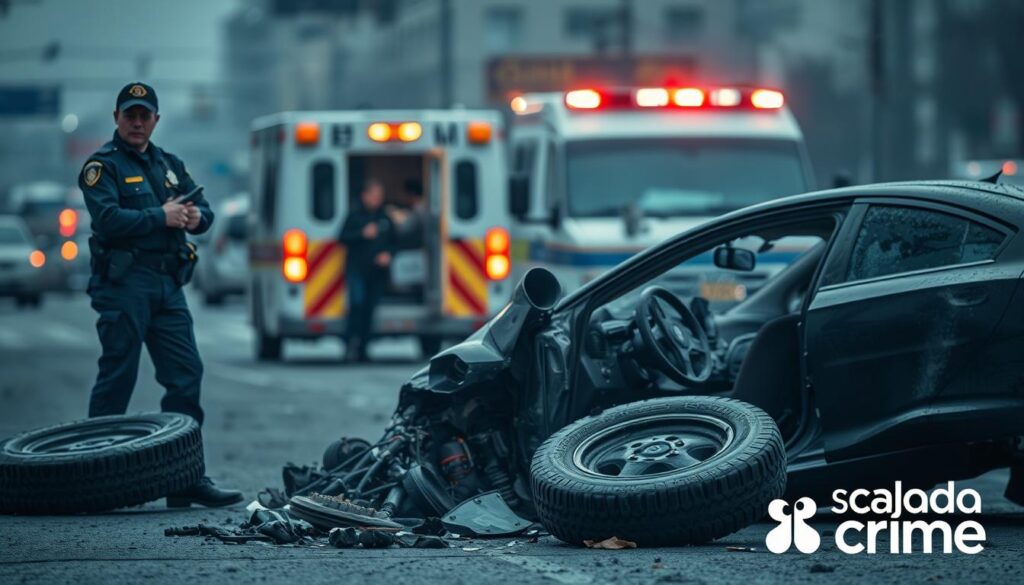
Legal Repercussions
Risky driving has severe legal penalties in Canada. Offenders might pay big fines, lose their licenses, or go to jail. Speeding, drunk driving, and reckless actions are examples. They risk lives and bring tough penalties to encourage safe driving.
Social and Economic Impacts
Risky driving leaves deep social scars. Families and communities face loss and injury, causing emotional pain. The economic toll is also heavy. The costs of medical care, damaged property, and insurance strain finances for everyone. Following driving laws and prevention can help reduce these problems.
Conclusion
We’re wrapping up this detailed guide, and it’s clear that stopping risky driving takes teamwork. Sticking to traffic safety rules is key. We must understand and follow laws at all levels to drive safely. It’s all about getting to your destination without harm to yourself or others.
Adding defensive driving skills to your everyday routine really helps. Keep an eye on your surroundings, stay a safe distance from other cars, and communicate well. Also, it’s vital to share the road with walkers, bikers, cyclists, and big trucks to keep everyone safe.
Tech like Advanced Driver Assistance Systems (ADAS) and other safety tools in cars play a big part in making roads safer. These tools, with our own careful driving and ongoing learning, can lead to fewer accidents and save lives. Remember, by practicing these safety tips, you’re helping create a safer driving world.

